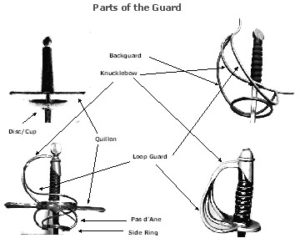Below is an explanation of the main sword parts.
The Pommel
The pommel is at the near end of the complete sword, at the top of the handle. It is meant to act as a counterweight to the blade so that the sword doesn’t feel so heavy in the hand. In general, heavy blades are matched with heavy pommels, and light blades with light pommels or even no pommel at all. But this is not a hard and fast rule. For instance, military sabres usually have no counterweight, so that cutting motions are harder to stop.
The Handle
This is the part you hold. It is sometimes called the grip, but technically the grip refers only to the leather or wire wrapping found on some handles. So … every sword has a handle, but not all handles have grips.
The Guard
The guard is the metal part that protects the hand, and is sometimes wrongly called the hilt. The guard is merely whatever is between the handle and the blade, and can be as simple as a flat cross piece or as complex and ornate as the 17th century cage hilt rapiers.
The Hilt
Everything that isn’t the blade. Therefore the hilt is the combination of pommel, handle, and guard. When you see a sword in a scabbard, the blade is hidden, and everything else that is visible is the hilt.
The Blade
The essential part of a sword, as opposed to the hilt. The blade is the length of steel that actually does the cutting.
The blade of a sword has two parts. The blade proper is the part that is visible. But what you can’t see is the rest of the steel which continues through the handle and then into the pommel. That part is called the tang. For most blades, the tang is much narrower than the exposed blade, and the site of the abrupt narrowing is called the shoulder. The hilt rests on the shoulder of the blade.
The blade proper is itself loosely divided into three sections: forte (near the hilt), middle, and foible (near the tip). Generally, a fighter must use the foible to attack and the forte to block. Some blades have grooves running lengthwise which are called fullers. Fullers allow the blade to be both lighter and stronger (and has nothing to do with the wound created. There is no such thing as a “blood groove” for swords or knives).
Some of the thinner sporting blades may have a tip that has been blunted with a wider flat “nailhead”, referred to as the button, which may or may not be covered in rubber or leather for additional safety. Stage swords never use a covered button.
The terms blade and sword have sometimes been used interchangeably, which is unfortunate when someone tries to purchase a weapon. Many ask for a “blade” thinking that they are getting a complete weapon, but all they get is a strand of steel and no way to hold on to it.
The Sheath/Scabbard
A sheath or scabbard has two functions: 1) to cover the blade, protecting it from moisture and others from accidental injury, and 2) to allow the sword to be worn.
A sheath is made of soft material (leather, cloth, etc.) and is relatively pliant. Most knives are housed in sheaths.
A scabbard is made of hard material (steel, wood, plastic, etc), whether or not covered by a soft material. Most swords are in scabbards, which are fully rigid even when empty.
Do you have other questions? Need specifics? Feel free to ask!

